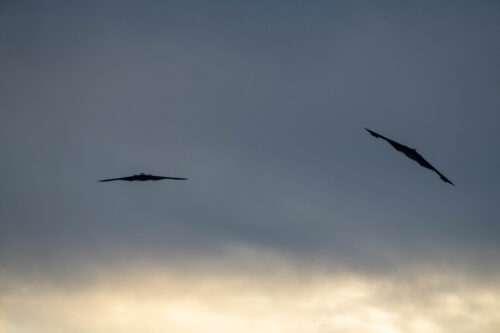Northrop Grumman, in collaboration with the U.S. Air Force, achieved a significant milestone by successfully showcasing an innovative Integrated Airborne Mission Transfer (IAMT) system for the B-2 Spirit bomber. This achievement took place during a two-day demonstration event held at Whiteman Air Force Base, Missouri, last month. The IAMT system, part of Northrop Grumman’s B-2 Collaborative Combat Communication (B2C3) Spiral 1 program, marks a pivotal advancement in the ongoing modernization efforts that center around the application of digital engineering.

During the demonstration, the IAMT system demonstrated its prowess by facilitating a seamless and efficient transfer of new mission parameters directly into the B-2’s onboard computers. This automated, digital process eliminates the need for pilots to manually input mission data, ensuring faster and more accurate updates to the aircraft’s capabilities.
The demonstration event centered around B-2 No. 1086, known as the Spirit of Kitty Hawk, which was specially equipped with Northrop Grumman’s Multi-Mission Domain (MMD) open-mission architecture. The MMD architecture offers a transformative approach, separating the B-2’s mission systems from its flight-critical systems. This separation allows for the incorporation of new capabilities without the need for extensive testing, resulting in rapid integration of cutting-edge features and enhanced capabilities.
The innovative MMD architecture seamlessly integrated with the B-2’s Adaptable Communications Suite (ACS), forming a cohesive ecosystem that streamlined the transfer of mission parameters. In practice, the aircrew received incoming transmissions from a ground station, which were then directly loaded into the B-2’s Disk Drive Unit via the MMD interfaces. This process ensures swift and accurate updates to the aircraft’s systems, enabling aircrews to focus more on mission execution within the dynamic battlespace.
The IAMT system’s achievement is not only a leap forward in technological capability but also a critical enhancement to the B-2’s operational effectiveness. With traditional methods, aircrews manually transferred mission updates from the ACS, introducing the potential for errors and delays. The IAMT system’s direct and automated transfer mitigates these risks, enhancing the overall precision and efficiency of the mission execution process.
The B-2’s modernization journey is deeply intertwined with the evolution of its communication and operational capabilities. Nikki Kodama, Vice President and B-2 Program Manager at Northrop Grumman, emphasized the importance of these advancements. She highlighted the B-2’s ability to effectively communicate and operate within Advanced Battle Management Systems (ABMS) and the Joint All-Domain Command and Control (JADC2) environment, which is essential for staying ahead of evolving threats.
As the IAMT system’s success underscores Northrop Grumman’s commitment to innovation, it also paves the way for further progress in navigation technologies. The partnership between Northrop Grumman, the U.S. Air Force, and other stakeholders positions the B-2 bomber at the forefront of digital transformation and enhanced operational capabilities. With the IAMT system’s success as a testament, ongoing modernization efforts promise to solidify the B-2’s pivotal role in future defense strategies.
While the IAMT system’s demonstration showcased its capabilities, Northrop Grumman’s dedication continues to be evident. The B2C3 Spiral 1 program aims to extend the digital communications capabilities to the entire B-2 fleet, comprising 20 aircraft. These modifications, undertaken at Whiteman Air Force Base, signify a commitment to ensuring the B-2 remains a formidable force in the years to come.
For more information, hit the Source below